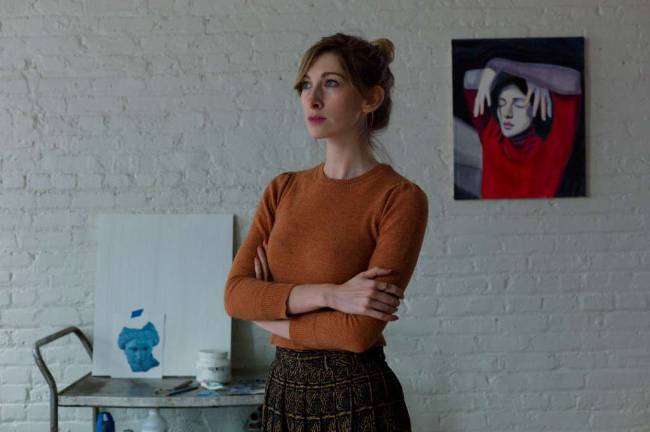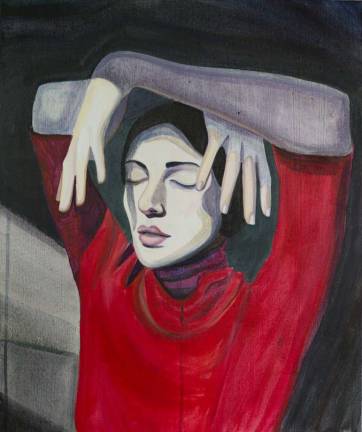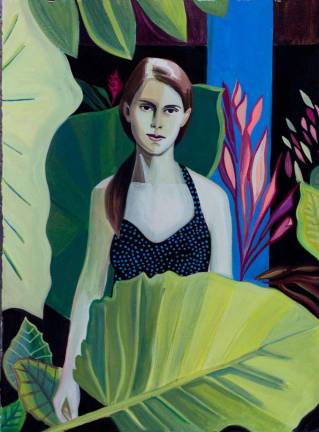Caris Reid: These Are Your Dreams



Don't be surprised if you have déjà vu looking at Caris Reid's artwork. There's a recognizably eerie nostalgia to all of her pieces. The colors are alternately bright and haunting. Her subjects are beautiful and cold all at once. Where have I seen this before? You'll wonder. And then it'll hit you. These are your dreams.
A wanderlust child, Reid spent most of her childhood moving from place to place. Her father worked in the hotel business, and was commonly uprooted from one locale to the next, giving her lots of time to daydream. She landed in Dallas for the last few years of high school, went to Boston for art school and landed in New York City where she has since worked as an artist. I had the chance to talk to Reid about her work at Dossier and the Oracle Club, keeping it in the present and lovely dancers.
I've seen a couple of your new paintings, which feature striking women in very elegant poses. Where did this series come from? I started having really strong visions in my head of women I knew who were all dancers, striking really strong kind of introspective poses that were in the vocabulary of dance. The images kept reappearing in my head until I realized I needed to approach the women and take pictures of them. I invited them to my studio separately, presented them with a pose, took a picture, showed it to them and allowed them to reinterpret the pose. One of the women I contacted is a ballerina who's dancing Swan Lake right now. Another was a dancer I've known for a while. She was 9 months pregnant at the time. I photographed Caroline, who's the lead singer of Chairlift and has a background in dance. I was really inspired by a video she did, called "Amanaemonesia", directed by Tom Hines. There's a pose she does where her fingers are sort of spidering down from her face. It's really striking, so I presented her with a version of that pose and it ended up becoming this posture of intense self-focus. Like she was performing self-hypnosis. Your past work deals a lot with the haunting nature of childhood, but it seems like your subjects are maturing into the lost nature of adulthood. How did that come about? I think I'm trying to look back less and look forward. A lot of my past work has dealt with source imagery and I've spent a lot of time meditating on past events and painting portraits of people from the past as if they were present. Doing portraits of a 19th century dancer, with an intimacy as though she were a real friend. I realized that I was looking into the past for things that I could find in the present. Part of this current project was about finding the Loie Fuller and Maude Allen of our generation.
Who are they? They both were dancers from the 19th century who had a slightly provocative and intuitive way of moving that was deeply rooted in femininity and seemed to reach for something through dance that delved into the spiritual. I wanted to push myself to engage with the present. So much of my creativity is rooted in the people I surround myself with. I know people like Loie Fuller who exist now.
How has getting back to the present been for you? I think it's always a struggle to stay connected to the present. I think it's natural for the mind to drift to the past and the future. But I think the practice of painting is by nature a meditative practice. I'm more focused on being connected to the now.
I noticed a very beautiful photo on your website, Lucy Among Leaves. Hawaii. It stands out as being a more intimate portrait, with more color than a lot of your other paintings. What's the story behind it? That's a portrait I did of my youngest sister Lucy. I've been painting and photographing her since we were both really little. She's actually become a very talented photographer and has begun shooting me as well.
How do you feel being the subject? In the case of my sister it seems like an even exchange between siblings. And I like that we have that kind of creative dialogue, and alternate way of interpreting each other that exists independently from our relationship and patterning of communicating since we were little. The photos and paintings we take of each other speak to our relationship, but also exist independently of it.
When will we be able to snag a look of your next series? Hopefully in the next couple of months. I'm in the process of curating an art portfolio for the spring issue of Dossier.
How long have you been affiliated with them? Four years. I started writing for them during an artist residency in Berlin a few years ago.
Tell me a little about the workshops you're holding on Tuesday nights. Two dear friends of mine, Jenna Gribbon who's a painter and Julian Tepper started an artist's salon two months ago in Long island City, called the Oracle Club. There's a library and a writers room, but the library is modeled after Whistler's Peacock Room. There's a room with giant leafy plants painted by Jenna. A beautiful studio.
They approached me about teaching a class there. I've been teaching a weekly collage class. Every week has a theme and a tightly curated grouping of images that fit the theme. It's been cool. I wasn't sure who was going to show up for the classes, but it's been very creative people. I didn't expect them to show up since it's something they do naturally, but I've had a lot of artists and designers and graphic designers, they've all been showing up doing brilliant stuff. It's more about process than it is progress, and the group setting of working with music playing brings back the arts 'n crafts of kindergarten. Next weeks class is "Night of the Iconoclast." The space itself is enchanting.